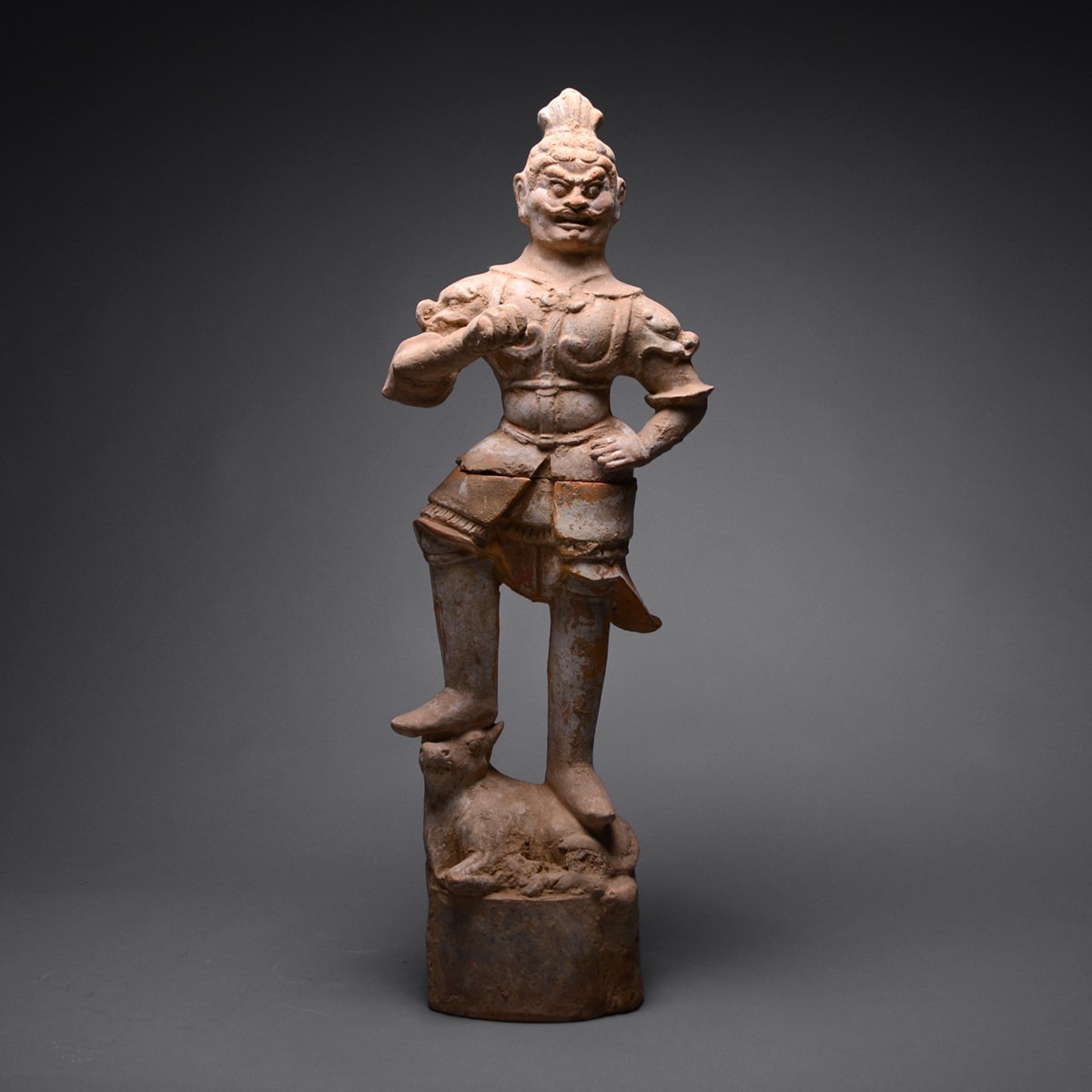T'ang Sculpture of a Lokapala, 618 CE - 907 CE
Terracotta
H.013
Further images
This figure is positioned with one arm raised fist clenche as if once grasping a weapon and the other arm resting on the hip. One leg is fixed while the...
This figure is positioned with one arm raised fist clenche as if once grasping a weapon and the other arm resting on the hip. One leg is fixed while the other is raised atop the head of an ox tha serves as the base. The figure is dressed in layers of robes beneath clad armo cinched by a wide belt. The loos end of his robe appear to flow in the wind. Tall boots with a lapel reach th knee. His long slender,
well-proportioned body distinguishes this figure from other depictions of Dev Kings who are often portrayed as stout and burly. An iconographical feature o the Deva King is the topknot, which in this figure, is shown as part of hi elaborate hairdo.
The “Deva King” is an image of fear and respect. Borne out of a synthesis of the indigenous Chinese “Heavenly Kings,”
legendary guardians of the four directions, and the Buddhist “Guardia Kings,” lopakalas, these supernatural beings were held in high esteem amon T'ang burial objects for their protective role. They were presented a supernatural beings, with facial features and body proportions unlike those o ordinary human. Their ferociou expressions and menacing gestures are borrowed from their Buddhist counterparts,
and their hair is often depicted pulled up into a distinctive knot in th fashion of Buddhist deities. Up to 1.5 meters tall, they trample on evil in th form of a small demon, or they stand on an ox, symbolizing that the king is th guardian of the south.
T'ang figurines reached their peak in the first half o the eighth century, just before the An Lushan Rebellion which resulted in th weakening of the dynasty and later persecution of Buddhism. They are considered to be the finest examples of Chinese burial objects. The important role assigned to these models in T'ang tomb arrangement and their significance as status symbols and powerful guardians protecting th dead meant that these clay figures became luxury objects. Created during one of the greatest periods in Chinese history, the reflect the artistic vitality of the time, the re-ordering of social an political life, and give a unique perspective into the luxurious an sophisticated world of contemporary upper class life.
well-proportioned body distinguishes this figure from other depictions of Dev Kings who are often portrayed as stout and burly. An iconographical feature o the Deva King is the topknot, which in this figure, is shown as part of hi elaborate hairdo.
The “Deva King” is an image of fear and respect. Borne out of a synthesis of the indigenous Chinese “Heavenly Kings,”
legendary guardians of the four directions, and the Buddhist “Guardia Kings,” lopakalas, these supernatural beings were held in high esteem amon T'ang burial objects for their protective role. They were presented a supernatural beings, with facial features and body proportions unlike those o ordinary human. Their ferociou expressions and menacing gestures are borrowed from their Buddhist counterparts,
and their hair is often depicted pulled up into a distinctive knot in th fashion of Buddhist deities. Up to 1.5 meters tall, they trample on evil in th form of a small demon, or they stand on an ox, symbolizing that the king is th guardian of the south.
T'ang figurines reached their peak in the first half o the eighth century, just before the An Lushan Rebellion which resulted in th weakening of the dynasty and later persecution of Buddhism. They are considered to be the finest examples of Chinese burial objects. The important role assigned to these models in T'ang tomb arrangement and their significance as status symbols and powerful guardians protecting th dead meant that these clay figures became luxury objects. Created during one of the greatest periods in Chinese history, the reflect the artistic vitality of the time, the re-ordering of social an political life, and give a unique perspective into the luxurious an sophisticated world of contemporary upper class life.







